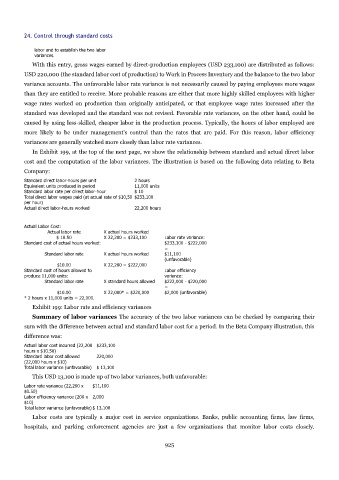Page 924 - Accounting Principles (A Business Perspective)
P. 924
24. Control through standard costs
labor and to establish the two labor
variances.
With this entry, gross wages earned by direct-production employees (USD 233,100) are distributed as follows:
USD 220,000 (the standard labor cost of production) to Work in Process Inventory and the balance to the two labor
variance accounts. The unfavorable labor rate variance is not necessarily caused by paying employees more wages
than they are entitled to receive. More probable reasons are either that more highly skilled employees with higher
wage rates worked on production than originally anticipated, or that employee wage rates increased after the
standard was developed and the standard was not revised. Favorable rate variances, on the other hand, could be
caused by using less-skilled, cheaper labor in the production process. Typically, the hours of labor employed are
more likely to be under management's control than the rates that are paid. For this reason, labor efficiency
variances are generally watched more closely than labor rate variances.
In Exhibit 199, at the top of the next page, we show the relationship between standard and actual direct labor
cost and the computation of the labor variances. The illustration is based on the following data relating to Beta
Company:
Standard direct labor-hours per unit 2 hours
Equivalent units produced in period 11,000 units
Standard labor rate per direct labor-hour $ 10
Total direct labor wages paid (at actual rate of $10,50 $233,100
per hour)
Actual direct labor-hours worked 22,200 hours
Actual Labor Cost:
Actual labor rate X actual hours worked
$ 10.50 X 22,200 = $233,100 Labor rate variance:
Standard cost of actual hours worked: $233,100 - $222,000
=
Standard labor rate X actual hours worked $11,100
(unfavorable)
$10.00 X 22,200 = $222,000
Standard cost of hours allowed to Labor efficiency
produce 11,000 units: variance:
Standard labor rate X standard hours allowed $222,000 - $220,000
=
$10.00 X 22,000* = $220,000 $2,000 (unfavorable)
* 2 hours x 11,000 units = 22,000.
Exhibit 199: Labor rate and efficiency variances
Summary of labor variances The accuracy of the two labor variances can be checked by comparing their
sum with the difference between actual and standard labor cost for a period. In the Beta Company illustration, this
difference was:
Actual labor cost incurred (22,200 $233,100
hours x $10.50)
Standard labor cost allowed 220,000
(22,000 hours x $10)
Total labor variance (unfavorable) $ 13,100
This USD 13,100 is made up of two labor variances, both unfavorable:
Labor rate variance (22,200 x $11,100
$0.50)
Labor efficiency variance (200 x 2,000
$10)
Total labor variance (unfavorable) $ 13,100
Labor costs are typically a major cost in service organizations. Banks, public accounting firms, law firms,
hospitals, and parking enforcement agencies are just a few organizations that monitor labor costs closely.
925

